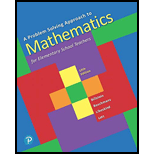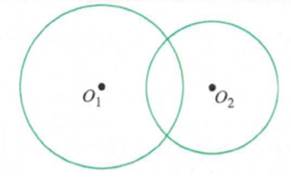
Problem Solving Approach to Mathematics for Elementary School Teachers
13th Edition
ISBN: 9780135184097
Author: BILLSTEIN
Publisher: PEARSON CO
expand_more
expand_more
format_list_bulleted
Concept explainers
Textbook Question
Chapter 14.2B, Problem 16A
In which line will the two intersecting circles reflect onto themselves; that is, the image of the circles will be the same two circles?

Expert Solution & Answer
Want to see the full answer?
Check out a sample textbook solution
Students have asked these similar questions
PLease solve handwritten, dont use AI.
please solve the question handwritten without AI
Can you explain this statement below in layman's terms?
Secondary Analysis with Generalized Linear Mixed Model with clustering for Hospital Center and ICUvs Ward EnrolmentIn a secondary adjusted analysis we used generalized linear mixed models with random effects forcenter (a stratification variable in the primary analyses). In this analysis, the relative risk for the primaryoutcome of 90-day mortality for 7 versus 14 days of antibiotics was 0.90 (95% Confidence Interval [CI]0.78, 1.05).
Chapter 14 Solutions
Problem Solving Approach to Mathematics for Elementary School Teachers
Ch. 14.1 - Prob. 1MCCh. 14.1 - Prob. 3MCCh. 14.1 - Prob. 5MCCh. 14.1 - Prob. 6MCCh. 14.1 - Prob. 7MCCh. 14.1 - A drawing of a cube, shown in the following...Ch. 14.1 - Wall stenciling has been used to obtain an effect...Ch. 14.1 - Prob. 10MCCh. 14.1 - The following figure is a partial tessellation of...Ch. 14.1 - Prob. 12MC
Ch. 14.1 - Prob. 13MCCh. 14.1 - Prob. 14MCCh. 14.1 - Prob. 15MCCh. 14.1 - Prob. 18MCCh. 14.1 - Prob. 19MCCh. 14.1 - Prob. 20MCCh. 14.1 - Prob. 21MCCh. 14.1 - Karrin claims that centers of rotation must be at...Ch. 14.1 - A student asks if the image seen through a...Ch. 14.1 - Jillian wants to know why a regular pentagon will...Ch. 14.1 - Prob. 26MCCh. 14.1 - Prob. 1NAEPCh. 14.1 - Prob. 2NAEPCh. 14.1 - Prob. 3NAEPCh. 14.1A - For each of the following, find the image of the...Ch. 14.1A - Prob. 2ACh. 14.1A - Find the coordinates of the image for each of the...Ch. 14.1A - Prob. 4ACh. 14.1A - Prob. 7ACh. 14.1A - Prob. 8ACh. 14.1A - Prob. 9ACh. 14.1A - Prob. 11ACh. 14.1A - Prob. 12ACh. 14.1A - Prob. 13ACh. 14.1A - Prob. 14ACh. 14.1A - Prob. 15ACh. 14.1A - A 1-inch blue square piece of sidewalk chalk is...Ch. 14.1A - Prob. 17ACh. 14.1A - Prob. 18ACh. 14.1A - Prob. 19ACh. 14.1A - Prob. 20ACh. 14.1A - Prob. 22ACh. 14.1A - Prob. 23ACh. 14.1A - Prob. 24ACh. 14.1A - Prob. 25ACh. 14.1A - Prob. 26ACh. 14.1A - Prob. 27ACh. 14.1A - Prob. 28ACh. 14.1B - Prob. 2ACh. 14.1B - Prob. 3ACh. 14.1B - Prob. 4ACh. 14.1B - Prob. 7ACh. 14.1B - Prob. 11ACh. 14.1B - Prob. 12ACh. 14.1B - Prob. 13ACh. 14.1B - Prob. 14ACh. 14.1B - Prob. 15ACh. 14.2 - Prob. 1MCCh. 14.2 - Prob. 2MCCh. 14.2 - Prob. 3MCCh. 14.2 - Prob. 4MCCh. 14.2 - Prob. 5MCCh. 14.2 - Prob. 6MCCh. 14.2 - Prob. 7MCCh. 14.2 - Prob. 8MCCh. 14.2 - Prob. 9MCCh. 14.2 - Prob. 13MCCh. 14.2 - Prob. 15MCCh. 14.2 - Prob. 17MCCh. 14.2 - Prob. 18MCCh. 14.2 - Prob. 19MCCh. 14.2 - Prob. 20MCCh. 14.2 - Prob. 22MCCh. 14.2 - Prob. 1NAEPCh. 14.2 - Prob. 2NAEPCh. 14.2 - Prob. 3NAEPCh. 14.2 - Prob. 4NAEPCh. 14.2 - Prob. 5NAEPCh. 14.2A - Assessment 14-2A Describe how to find the image of...Ch. 14.2A - Prob. 2ACh. 14.2A - Assessment 14-2A Determine the final result when...Ch. 14.2A - Prob. 4ACh. 14.2A - Assessment 14-2A a. Refer to the following figure...Ch. 14.2A - Prob. 6ACh. 14.2A - a. Reflect triangle ABC across line j, then across...Ch. 14.2A - Assessment 14-2A Given ABC and its reflection...Ch. 14.2A - Prob. 9ACh. 14.2A - Prob. 10ACh. 14.2A - Decide whether a reflection, a translation, a...Ch. 14.2A - a. Conjecture what the image of a point with...Ch. 14.2A - Prob. 16ACh. 14.2A - Prob. 17ACh. 14.2A - Prob. 18ACh. 14.2A - Point P is the image of P not shown under a glide...Ch. 14.2A - Consider the glide reflection determined by the...Ch. 14.2B - Prob. 1ACh. 14.2B - Prob. 2ACh. 14.2B - Determine the final result when ABCis reflection...Ch. 14.2B - Prob. 4ACh. 14.2B - Prob. 6ACh. 14.2B - Prob. 7ACh. 14.2B - Prob. 8ACh. 14.2B - Prob. 9ACh. 14.2B - Prob. 10ACh. 14.2B - Prob. 11ACh. 14.2B - Prob. 12ACh. 14.2B - Prob. 13ACh. 14.2B - Prob. 14ACh. 14.2B - Prob. 15ACh. 14.2B - In which line will the two intersecting circles...Ch. 14.2B - Prob. 18ACh. 14.2B - If PQ is the image PQ not shown under a glide...Ch. 14.2B - Prob. 20ACh. 14.2B - Prob. 21ACh. 14.3 - Prob. 1MCCh. 14.3 - Prob. 2MCCh. 14.3 - Prob. 3MCCh. 14.3 - Prob. 5MCCh. 14.3 - Prob. 6MCCh. 14.3 - Prob. 7MCCh. 14.3 - Prob. 8MCCh. 14.3 - Prob. 9MCCh. 14.3 - Prob. 10MCCh. 14.3 - Prob. 12MCCh. 14.3 - Prob. 13MCCh. 14.3 - Prob. 14MCCh. 14.3 - Prob. 15MCCh. 14.3 - Prob. 16MCCh. 14.3 - Prob. 17MCCh. 14.3A - In the following figures, describe a sequence of...Ch. 14.3A - Prob. 2ACh. 14.3A - In each of the following drawings, find...Ch. 14.3A - Prob. 4ACh. 14.3A - AB is the image of a candle AB produced by a box...Ch. 14.3A - Prob. 6ACh. 14.3A - Prob. 7ACh. 14.3A - Prob. 8ACh. 14.3A - Prob. 9ACh. 14.3A - Prob. 10ACh. 14.3A - Prob. 11ACh. 14.3A - Prob. 12ACh. 14.3A - Prob. 13ACh. 14.3B - Prob. 1ACh. 14.3B - Prob. 2ACh. 14.3B - Prob. 4ACh. 14.3B - Prob. 5ACh. 14.3B - Prob. 6ACh. 14.3B - Prob. 7ACh. 14.3B - Prob. 8ACh. 14.3B - Prob. 9ACh. 14.3B - Prob. 11ACh. 14.3B - Prob. 12ACh. 14.3B - Prob. 13ACh. 14.CR - Prob. 1CRCh. 14.CR - Prob. 2CRCh. 14.CR - Prob. 3CRCh. 14.CR - Prob. 4CRCh. 14.CR - Given that STAR in the figure shown is a...Ch. 14.CR - Prob. 6CRCh. 14.CR - Given that SNOSWO in the following figure,...Ch. 14.CR - Prob. 8CRCh. 14.CR - Prob. 9CRCh. 14.CR - Prob. 10CRCh. 14.CR - If a translation determined by (x,y)(x+3,y2) is...Ch. 14.CR - Prob. 12CRCh. 14.CR - Prob. 13CRCh. 14.CR - On a 1-m equilateral triangle pool table, a ball...Ch. 14.CR - Prob. 15CRCh. 14.CR - Prob. 16CRCh. 14.CR - Prob. 17CRCh. 14.CR - Prob. 18CRCh. 14.CR - Prob. 19CRCh. 14.CR - Prob. 21CRCh. 14.CR - Prob. 22CRCh. 14.CR - Prob. 23CRCh. 14.CR - Prob. 24CRCh. 14.CR - Prob. 25CRCh. 14.CR - Prob. 26CRCh. 14.CR - What dilation, if any, allows a line with equation...Ch. 14 - Prob. 1NT
Knowledge Booster
Learn more about
Need a deep-dive on the concept behind this application? Look no further. Learn more about this topic, subject and related others by exploring similar questions and additional content below.Similar questions
- 2 Solve for (x, y, z) in the set of linear, inhomogeneous equations: 2x+5y + z = 2 x+y+2x=1 2+52=3.arrow_forwardProve by induction that for any natural number N, 1 N Σ42 = 6 N(N + 1)(2N + 1). k=1 Indicate clearly where you use the inductive hypothesis.arrow_forward2x-y=1 x+2y=7 y = 2x + 2 3x + 2y = 4 x+3y=0 x-3y=6 8 4x-2y=7 x + 3y = 7 10 2x-2y=5 2x + 3y+ 1 = 0 Ke int lin Chapter 14arrow_forward
- (a) (b) Let A, B be disjoint subsets of a set X. Show that AC Bc. Use proof by contradiction to show that for any a, b = R, if a is rational and b is irrational then ba is irrational.arrow_forward(d) Consider the sequences (xn), (yn) defined recursively as follows: Xn+1 = xn2yn, i. ii. n, Yn+1=Yn2xn for n ≥ 1, x1 = 1, y₁ = 2. Calculate x2, y2 and x3, Y3. - Show using induction or otherwise that for any natural number - Xn+Yni = (1+2i)". Hence or otherwise, show that for any natural number n, iii. Zn = (V5)” cos(n arctan2), n = (V5)” sin(n arctan 2).arrow_forward2. (a) For each of the following functions, decide whether it is injective, and whether it is surjective. Justify your answers. i. f: Z → 22 Z 3z +1 ii. 9: C→ 22 Re(z) + Im(z)arrow_forward
- Not use ai pleasearrow_forward2. Given f(0) = (2 cos 0)² - 3sin²0. 1 a. Show that f(0) = ½ + ½ 7 + - cos cos 20. 2 2 b. Hence, find the exact value of √² 0 ƒ (0) do.arrow_forward2. Given f(0) = (2 cos 0)² - 3sin²0. 1 a. Show that f(0) = ½ + ½ 7 +-cos cos 20. 2 2 b. Hence, find the exact value of √ ƒ (0) d0.arrow_forward
- Not use ai pleasearrow_forwardIn a crossover trial comparing a new drug to a standard, π denotes the probabilitythat the new one is judged better. It is desired to estimate π and test H0 : π = 0.5against H1 : π = 0.5. In 20 independent observations, the new drug is better eachtime.(a) Find and plot the likelihood function. Give the ML estimate of π (Hint: youmay use the plot function in R)arrow_forwardQ9. If A and B are two events, prove that P(ANB) ≥ 1 − P(Ā) – P(B). [Note: This is a simplified version of the Bonferroni inequality.] -arrow_forward
arrow_back_ios
SEE MORE QUESTIONS
arrow_forward_ios
Recommended textbooks for you

 College Algebra (MindTap Course List)AlgebraISBN:9781305652231Author:R. David Gustafson, Jeff HughesPublisher:Cengage Learning
College Algebra (MindTap Course List)AlgebraISBN:9781305652231Author:R. David Gustafson, Jeff HughesPublisher:Cengage Learning Mathematics For Machine TechnologyAdvanced MathISBN:9781337798310Author:Peterson, John.Publisher:Cengage Learning,
Mathematics For Machine TechnologyAdvanced MathISBN:9781337798310Author:Peterson, John.Publisher:Cengage Learning, Elementary Geometry For College Students, 7eGeometryISBN:9781337614085Author:Alexander, Daniel C.; Koeberlein, Geralyn M.Publisher:Cengage,
Elementary Geometry For College Students, 7eGeometryISBN:9781337614085Author:Alexander, Daniel C.; Koeberlein, Geralyn M.Publisher:Cengage, Holt Mcdougal Larson Pre-algebra: Student Edition...AlgebraISBN:9780547587776Author:HOLT MCDOUGALPublisher:HOLT MCDOUGAL
Holt Mcdougal Larson Pre-algebra: Student Edition...AlgebraISBN:9780547587776Author:HOLT MCDOUGALPublisher:HOLT MCDOUGAL Elementary Geometry for College StudentsGeometryISBN:9781285195698Author:Daniel C. Alexander, Geralyn M. KoeberleinPublisher:Cengage Learning
Elementary Geometry for College StudentsGeometryISBN:9781285195698Author:Daniel C. Alexander, Geralyn M. KoeberleinPublisher:Cengage Learning


College Algebra (MindTap Course List)
Algebra
ISBN:9781305652231
Author:R. David Gustafson, Jeff Hughes
Publisher:Cengage Learning

Mathematics For Machine Technology
Advanced Math
ISBN:9781337798310
Author:Peterson, John.
Publisher:Cengage Learning,

Elementary Geometry For College Students, 7e
Geometry
ISBN:9781337614085
Author:Alexander, Daniel C.; Koeberlein, Geralyn M.
Publisher:Cengage,

Holt Mcdougal Larson Pre-algebra: Student Edition...
Algebra
ISBN:9780547587776
Author:HOLT MCDOUGAL
Publisher:HOLT MCDOUGAL

Elementary Geometry for College Students
Geometry
ISBN:9781285195698
Author:Daniel C. Alexander, Geralyn M. Koeberlein
Publisher:Cengage Learning
01 - Angles and Angle Measure in Degrees - Part 1 - Types of Angles & What is an Angle?; Author: Math and Science;https://www.youtube.com/watch?v=hy95VyPet-M;License: Standard YouTube License, CC-BY